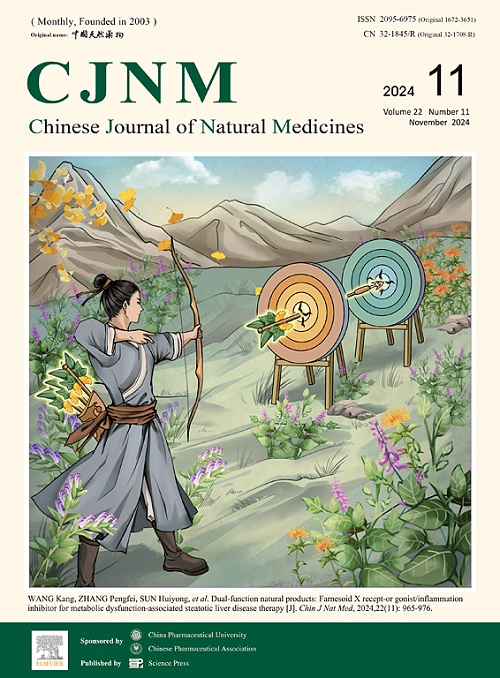Comprehensive analysis of the antibacterial activity of 5,8-dihydroxy-1,4-naphthoquinone derivatives against methicillin-resistant Staphylococcus aureus
IF 4.9
2区 医学
Q1 INTEGRATIVE & COMPLEMENTARY MEDICINE
引用次数: 0
Abstract
Given the increasing concern regarding antibacterial resistance, the antimicrobial properties of naphthoquinones have recently attracted significant attention. While 1,4-naphthoquinone and its derivatives have been extensively studied, the antibacterial properties of 5,8-dihydroxy-1,4-naphthoquinone derivatives remain relatively unexplored. This study presents a comprehensive in vitro and in vivo analysis of the antibacterial activity of 35 naturally sourced and chemically synthesized derivatives of 5,8-dihydroxy-1,4-naphthoquinone. Kirby-Bauer antibiotic testing identified three compounds with activity against methicillin-resistant Staphylococcus aureus (MRSA), with one compound (PNP-02) demonstrating activity comparable to vancomycin in minimum inhibitory concentration, minimum bactericidal concentration (MBC), and time-kill assays. Microscopic and biochemical analyses revealed that PNP-02 adversely affects the cell wall and cell membrane of MRSA. Mechanistic investigations, including proteomic sequencing analyses, Western blotting, and RT-qPCR assays, indicated that PNP-02 compromises cell membrane integrity by inhibiting arginine biosynthesis and pyrimidine metabolism pathways, thereby increasing membrane permeability and inducing bacterial death. In an in vivo mouse model of skin wound healing, PNP-02 exhibited antibacterial efficacy similar to vancomycin. The compound demonstrated low toxicity to cultured human cells and in hemolysis assays and remained stable during serum incubation. These findings suggest that PNP-02 possesses promising bioactivity against MRSA and represents a potential novel antibacterial agent.
5,8-二羟基-1,4-萘醌衍生物对耐甲氧西林金黄色葡萄球菌抑菌活性的综合分析
鉴于对抗菌药物耐药性的日益关注,萘醌类药物的抗菌性能近年来引起了人们的广泛关注。虽然1,4-萘醌及其衍生物已被广泛研究,但5,8-二羟基-1,4-萘醌衍生物的抗菌性能仍相对未被探索。本研究对35种天然来源和化学合成的5,8-二羟基-1,4-萘醌衍生物的体外和体内抗菌活性进行了全面的分析。Kirby-Bauer抗生素测试鉴定出三种化合物对耐甲氧西林金黄色葡萄球菌(MRSA)具有活性,其中一种化合物(PNP-02)在最小抑制浓度、最小杀菌浓度(MBC)和时间杀伤试验中显示出与万古霉素相当的活性。显微镜和生化分析显示PNP-02对MRSA细胞壁和细胞膜有不良影响。机制研究,包括蛋白质组学测序分析,Western blotting和RT-qPCR分析,表明PNP-02通过抑制精氨酸生物合成和嘧啶代谢途径破坏细胞膜完整性,从而增加膜通透性并诱导细菌死亡。在体内小鼠皮肤创面愈合模型中,PNP-02表现出与万古霉素相似的抗菌效果。该化合物对培养的人类细胞和溶血试验显示出低毒性,并且在血清孵育期间保持稳定。这些发现表明PNP-02具有良好的抗MRSA活性,是一种潜在的新型抗菌剂。
本文章由计算机程序翻译,如有差异,请以英文原文为准。
求助全文
约1分钟内获得全文
求助全文
来源期刊

Chinese Journal of Natural Medicines
INTEGRATIVE & COMPLEMENTARY MEDICINE-PHARMACOLOGY & PHARMACY
CiteScore
7.50
自引率
4.30%
发文量
2235
期刊介绍:
The Chinese Journal of Natural Medicines (CJNM), founded and sponsored in May 2003 by China Pharmaceutical University and the Chinese Pharmaceutical Association, is devoted to communication among pharmaceutical and medical scientists interested in the advancement of Traditional Chinese Medicines (TCM). CJNM publishes articles relating to a broad spectrum of bioactive natural products, leading compounds and medicines derived from Traditional Chinese Medicines (TCM).
Topics covered by the journal are: Resources of Traditional Chinese Medicines; Interaction and complexity of prescription; Natural Products Chemistry (including structure modification, semi-and total synthesis, bio-transformation); Pharmacology of natural products and prescription (including pharmacokinetics and toxicology); Pharmaceutics and Analytical Methods of natural products.
 求助内容:
求助内容: 应助结果提醒方式:
应助结果提醒方式:


